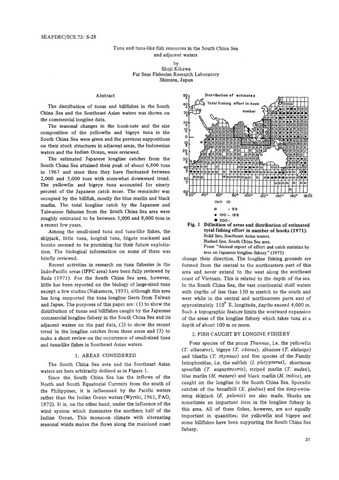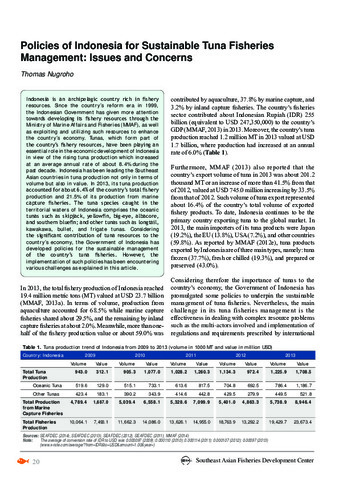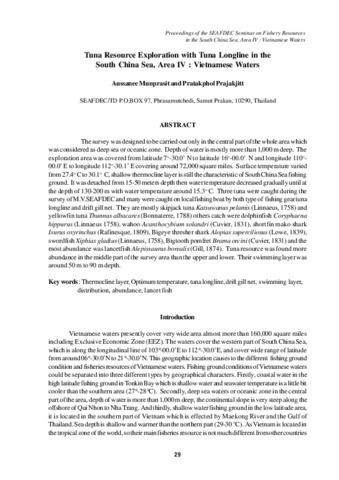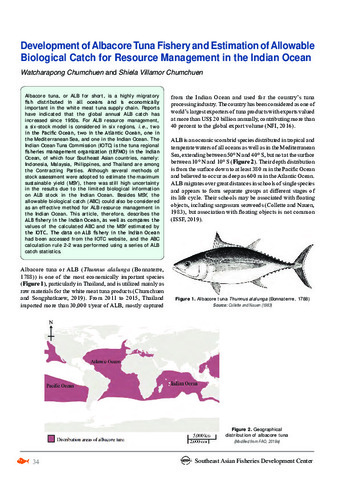Tuna and tuna-like fish resources in the South China Sea and adjacent waters
Share
trừu tượng
The distribution of tunas and billfishes in the South China Sea and the Southeast Asian waters was shown on the commercial longline data.
The seasonal changes in the hook-rate and the size composition of the yellowfin and bigeye tuna in the South China Sea were given and the previous suppositions on their stock structures in adjacent areas, the Indonesian waters and the Indian Ocean, were reviewed.
The estimated Japanese longline catches from the South China Sea attained their peak of about 6,800 tons in 1967 and since then they have fluctuated between 2,000 and 5,000 tons with somewhat downward trend. The yellowfin and bigeye tuna accounted for ninety percent of the Japanese catch more. The remainder was occupied by the billfish, mostly the blue marlin and black marlin. The total longline catch by the Japanese and Taiwanese fisheries from the South China Sea area were roughly estimated to be between 5,000 and 8,000 tons in a recent few years.
Among the small-sized tuna and tuna-like fishes, the skipjack, little tuna, longtail tuna, frigate mackerel and bonito seemed to be promising for their future exploitation. The biological information on some of them was briefly reviewed.
Recent activities in research on tuna fisheries in the Indo-Pacific areas (IPFC area) have been fully reviewed by Suda (1971). For the South China Sea area, however, little has been reported on the biology of large-sized tuna except a few studies (Nakamura, 1953), although this area has long supported the tuna longline fleets from Taiwan and Japan. The purposes of this paper are: (1) to show the distribution of tunas and billfishes caught by the Japanese commercial longline fishery in the South China Sea and its adjacent waters on the past data, (2) to show the recent trend in the longline catches from these areas and (3) to make a short review on the occurrence of small-sized tuna and tuna-like fishes in Southeast Asian waters.
Suggested Citation
Kikawa, S. (1977). Tuna and tuna-like fish resources in the South China Sea and adjacent waters. In Proceedings of the Technical Seminar on South China Sea Fisheries Resources, Bangkok, Thailand, 21-25 May 1973 (pp. 31-41). Tokyo, Japan: Japan International Cooperation Agency.
Chủ thể
tuna fisheries  ; finfish fisheries
; finfish fisheries  ; marine fisheries
; marine fisheries  ; pelagic fisheries
; pelagic fisheries  ; commercial species
; commercial species  ; longlining
; longlining  ; size distribution
; size distribution  ; seasonal distribution
; seasonal distribution  ; geographical distribution
; geographical distribution  ; fishing effort
; fishing effort  ; check lists
; check lists  ; natural resources
; natural resources  ; Thunnus albacares; Thunnus obesus; Thunnus alalunga; Thunnus thynnus; Istiophorus platypterus; Tetrapturus angustirostris; Kajikia audax; Makaira nigricans; Makaira mazara; Makaira indica; Xiphias gladius; Katsuwonus pelamis; South China Sea
; Thunnus albacares; Thunnus obesus; Thunnus alalunga; Thunnus thynnus; Istiophorus platypterus; Tetrapturus angustirostris; Kajikia audax; Makaira nigricans; Makaira mazara; Makaira indica; Xiphias gladius; Katsuwonus pelamis; South China Sea
 ; finfish fisheries
; finfish fisheries  ; marine fisheries
; marine fisheries  ; pelagic fisheries
; pelagic fisheries  ; commercial species
; commercial species  ; longlining
; longlining  ; size distribution
; size distribution  ; seasonal distribution
; seasonal distribution  ; geographical distribution
; geographical distribution  ; fishing effort
; fishing effort  ; check lists
; check lists  ; natural resources
; natural resources  ; Thunnus albacares; Thunnus obesus; Thunnus alalunga; Thunnus thynnus; Istiophorus platypterus; Tetrapturus angustirostris; Kajikia audax; Makaira nigricans; Makaira mazara; Makaira indica; Xiphias gladius; Katsuwonus pelamis; South China Sea
; Thunnus albacares; Thunnus obesus; Thunnus alalunga; Thunnus thynnus; Istiophorus platypterus; Tetrapturus angustirostris; Kajikia audax; Makaira nigricans; Makaira mazara; Makaira indica; Xiphias gladius; Katsuwonus pelamis; South China Sea
Related items
Showing items related by title, author, creator and subject.
-
Policies of Indonesia for sustainable tuna fisheries management: Issues and concerns
Nugroho, Thomas (Secretariat, Southeast Asian Fisheries Development Center, 2014)Indonesia is an archipelagic country rich in fishery resources. Since the country's reform era in 1999, the Indonesian Government has given more attention towards developing its fishery resources through the Ministry of ... -
Tuna resource exploration with tuna longline in the South China Sea, Area IV: Vietnamese waters
Munprasit, Aussanee; Prajakjitt, Pratakphol (Secretariat, Southeast Asian Fisheries Development Center, 2001)The survey was designed to be carried out only in the central part of the whole area which was considered as deep sea or oceanic zone. Depth of water is mostly more than 1,000 m deep. The exploration area was covered from ... -
Development of albacore tuna fishery and estimation of allowable biological catch for resource management in the Indian Ocean
Chumchuen, Watcharapong; Chumchuen, Shiela Villamor (Secretariat, Southeast Asian Fisheries Development Center, 2019)Albacore tuna, or ALB for short, is a highly migratory fish distributed in all oceans and is economically important in the white meat tuna supply chain. Reports have indicated that the global annual ALB catch has increased ...




